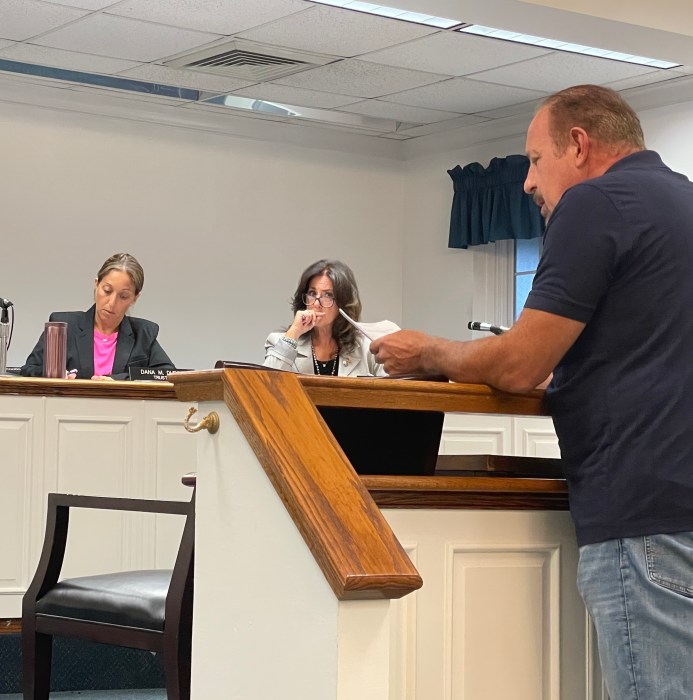New study could help determine more accurate quotas on summer flounder/fluke
Oyster Bay Harbor is known as a good fishing location, therefore the request of U.S. Senator Kirsten Gillibrand (D-NY) who urged the U.S. Commerce Secretary to immediately update the years-old national study assessing the population of summer flounder is welcome. The study could impact quotas for Long Island fishermen. With summer flounder season beginning, Senator Gillibrand pointed out that a new assessment is overdue and must include new scientific data to accurately determine the fish population and summer flounder quotas.
Tom Swiencki, of the Oyster Bay Marine Supply, explains: “Summer flounder is better known around here as fluke. South of New Jersey they call them summer flounder. That’s because they don’t have winter flounder, but we do.”
Mr. Swiencki said the fluke population is down from past numbers. “It’s definitely down from what it used to be. They put in regulations on the size that you can keep and all the big ones disappear. There is no problem catching undersized fluke. This year the regulations [from the Atlantic State Marine Fisheries Council] say you can keep them at 19-and-a-half inches. It’s easy to catch the small ones but it’s hard to catch the keepers. We keep culling out the big ones, and they are just left with the small fish.”
He said that while it is hard to catch the keepers, this year they lowered the size. “Last year the allowed size was 20 inches, so even though there are less than there were, they say there are more than last year.”
Patricia Aitken, Friends of the Bay executive director, said that according to NOAA, National Oceanography and Atmospheric Administration’s fishery service, the fluke population is going up. “Fishery management is always a controversial topic. It would seem in this case it is working, since the fluke population seems to be rebounding. It proves that conservation works.”
Senator Gillibrand wrote a letter to Commerce Secretary John Bryson requesting that the summer flounder benchmark assessment be placed on the stock assessment workshop roster of the Northeast Fisheries Science Center (NEFSC) at the earliest possible date. She said, “Summer flounder represents an extremely significant fishery on the east coast of the United States, and particularly in New York for the commercial, recreational and for-hire sectors… Science that regulates our fisheries should be both accurate and timely and further delay is simply unacceptable.”
For Long Island fishermen, summer flounder/fluke is one of the mainstays of region’s fishing industry, and are vital and help boost businesses, selling at $2.70 a pound in New York in 2009. The last stock assessment workshop conducted by NEFSC on summer flounder was in 2008, and Senator Gillibrand said a new on was initially scheduled for the spring of 2011. “However, it was removed from the roster in 2010 and never rescheduled. Winter flounder, one of the New England groundfish species of fish, was evaluated by the NEFSC in place of summer flounder in the early 2011.”
The senator added that typically, studies are renewed every three years. Both the fishing industry and academics have made requests since 2010 to begin a summer flounder/fluke benchmark assessment. Factoring in new peer-reviewed data on the species would improve both the reference points used to evaluate the stock and fishery and decrease the uncertainty levels on the overall estimate of stock population.
The senator said, “It is my understanding that the inclusion of this data would improve both the biological reference points used to evaluate the status of the stock and fishery, and decrease the uncertainty levels surrounding the overall estimate of stock biomass.”
Mr. Swiencki holds fishing contests all during the fishing season. “The flounder contests are over now. We take the winter flounder in April and May. The fluke contest just opened on May 1, so they are just starting to catch those now. The contests are run throughout the summer months. We have tournaments and derbies for all species. The only really large tournament we hold is with the Town of Oyster Bay in September, the Bluefish Tournament.”
FYI: Flounder is an unusual fish in that although it looks just like any other fish when it is born, it goes through a biological change so that the summer flounder/fluke is left-handed; that is, it lies on the bottom on its right side, with its eyes on its left-hand side, and its abdomen is on its left edge as it rests on the bottom. They are considered flatfish, which is what they look like. They are light colored on the bottom and different shades of dark on top to blend in with the area. That 20-inch fish should weigh in at about 3 to 3.5 pounds. They can be 3-feet-long and weigh 15 pounds. In 1948, a record fish was caught at Oak Beach, weighing in at 37 inches and 20 pounds.

































